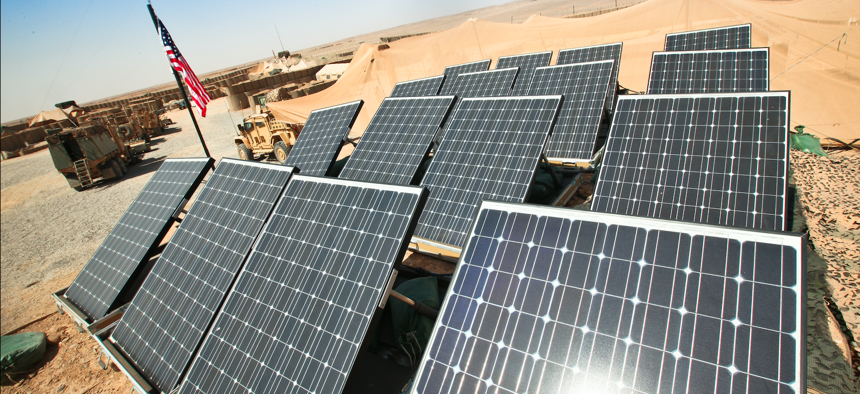
Solar panels sit atop HESCO barriers at Patrol Base Boldak, Helmand province, Afghanistan, in 2011. Cpl. Bryan Nygaard/U.S. Marines
The Military Value of the Defense Department’s Energy Efforts
As the Trump administration reviews climate and energy policies, they should do it with a key goal in mind.
President Trump has made his skepticism of his predecessor’s energy and climate policies fairly clear, from the rapid permitting of pipelines to his EPA Administrator’s public denial of carbon’s impact on the environment. No doubt the Defense Department’s policies and efforts in this area are in for some change as well. But before Trump administration officials issue any kind of blanket reversal, they should understand that the U.S. military has been taking a careful and calculated approach to climate and energy issues. They may find that they want to leave some of those policies in place after all.
Any review of DoD policies and programs should focus on their military value. Fundamentally, this boils down to asking of each one: Does it increase warfighter effectiveness? Does it reduce risk to our forces today or in the future? And does it improve DoD’s bottom line, freeing up funds to spend on other warfighting priorities?
For example, take the purchase of solar-energy systems for forward bases. The energy community has been fond of quoting then-General, now-Defense Secretary James Mattis, who emerged from his service in Iraq convinced that the military must be “unleashed from the tether of fuel.” Forward bases depended on fuel to run their generators; the vulnerable convoys that brought it were being attacked, requiring more forces to protect them. The fielding of solar energy systems to forward bases substantially reduced logistics requirements, saving lives.
Our fixed bases across the globe put troops at less risk to ensure their energy supply, yet efforts to produce electricity inside the installation fence-line (often with fields of solar panels) have a military value of their own – especially when microgrids are installed so power continues to flow even when the electric grid goes down. Critical missions are backed up by generator power, but most bases don’t have backup fuel supplies to keep them going for more than a few days.
One policy that may get some review is the pledge to put 3 gigawatts of renewable energy on our military installations by 2025. Even if emissions reductions are not considered, a business case exists for these projects. They are generally paid for by private developers, not taxpayers. Those developers are willing to pay up front because DoD agrees to buy their power for an extended period of time. This is still a good deal to DoD, because the DoD has been striking deals that reduce their current utility bills. This creates savings that can be plowed back into other DoD priorities.
In addition, whether or not the Trump administration decides to retain greenhouse-gas reduction targets, it is hard to argue that more energy efficiency isn’t a good idea. A Republican Congress passed and the Bush Administration signed the Energy Independence and Security Act of 2007 which set energy savings goals. Why? Because saving energy saves money. It’s just good business.
Most skepticism seems to be saved for climate change, and the Defense Department has been very careful not to devote significant resources to mitigate changes that are decades in the future. That said, DoD’s mandate is to prepare for contingencies. It makes sense, and costs little, to consider the possibility of instability that may be augmented by drought or food shortages; to think about the likelihood of increased Arctic resource extraction and transit as Arctic ice melts and how that change affects DoD missions; and to adopt master plans at our coastal installations that accommodate the risk of increased flooding, storm surges, and sea-level rise.
For example, a military service may decide to site new construction on higher ground rather than a flood zone. In this scenario, money that was already allocated would then be spent more wisely, with lower risk. If you had to put a building in the flood plain (and we often do — most Navy bases are in flood plains), then you’d want to avoid putting backup power and servers in the basement. This isn’t about certainty; it is about risk, and there’s a lot you can do to mitigate risk if you acknowledge the risk exists.
It’s certainly reasonable for the Trump administration to review energy and climate policies put in place by their predecessors. They should, however, ensure that any steps they take at DoD are made with military value first and foremost in their minds.
